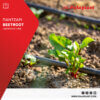
CARROT: Cultivation Characteristics and Irrigation
- Carrot (scientific name: Daucus carota, family: Apiaceae or Umbelliferae) is a biennial root vegetable widely cultivated for its edible roots, which are rich in nutrients, particularly beta-carotene, a precursor of vitamin A. Carrots are also a good source of vitamins B1, B2, and niacin.
- Wild carrots originate from Afghanistan and surrounding areas while carrots were known in Ancient Greece as medicinal herbs under the name “Staphylinos” or more commonly “Daucus.” In Europe, carrot cultivation began in the 13th century, with the edible roots being purple due to specific pigments. Their roots are fleshy, conical, and long, with an orange, yellow, or white color depending on the variety. Carrot varieties differ in shape, color, and length of root.
- Carrot cultivation requires careful management to ensure the growth of healthy and flavorful roots. With proper site selection, soil preparation, irrigation and good agricultural practices, farmers can achieve excellent results. Carrots thrive in sunny areas with light, well-drained soils. Sandy or loamy soils are ideal, allowing the roots to grow freely without deformities. The soil should be loose and free from stones and other obstacles that could hinder root development. Sowing is done directly into the soil in early spring or fall, depending on the climatic zone. Seeds should be sown at a depth of 0.5-1 cm, with a spacing of about 2-3 cm between seeds in a row. The rows should be spaced 30-40 cm apart to facilitate irrigation and aeration.
CARROT IRRIGATION
What are the water needs of carrots?
Proper irrigation is crucial for successful carrot cultivation, as it directly affects the quality, size, and flavor of the roots. Carrots need a consistent and even water supply throughout their growth. Key points in carrot irrigation include:
- Consistent Soil Moisture: The soil should remain constantly moist but not waterlogged. Excessive or insufficient moisture can cause problems such as cracked roots or delayed growth. Frequent but light irrigation is recommended, especially during the first weeks after sowing, to ensure germination and the growth of young plants.
- Avoid Frequent Moisture Fluctuations: Changes in soil moisture from very dry to very wet can cause irregular or cracked roots. To prevent such issues, the soil must remain consistently moist with regular, even irrigations.
- Adaptation to Climatic Conditions: During periods of drought or high temperatures, irrigation needs may increase. Conversely, in periods of high humidity or frequent rainfall, irrigation can be reduced.
- Timing of Irrigation: It is best to water early in the morning or late in the afternoon to reduce evaporation and allow time for the water to be fully absorbed by the soil.
What is the most suitable irrigation system for carrot cultivation?
Drip irrigation is the best method for carrots, as it provides slow and steady moisture, maintaining consistent soil moisture without flooding the plants. It also prevents soil erosion and root cracking. Alternatively, sprinkler irrigation can be used but must be done carefully to avoid excessive moisture on the foliage, which can lead to diseases.
Palaplast has a wide range of products that can be used to install a reliable and efficient drip irrigation system or irrigation with micro-sprinklers system for carrot cultivation:
- Irrigation pipes AGROPAL HDPE 80 και LDPE
- Pressure Compensating Driplines, Driplines (Paladrip – Palaplast, Paladrip-XL – Palaplast, Paladrip-Slim – Palaplast)
- Dripline fittings
- Clamp saddles
- Filters
- Micro-sprinklers


